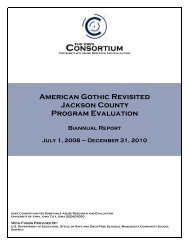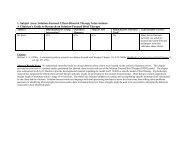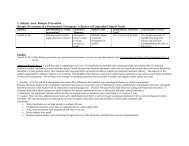Scott County Substance Use Epidemiological Profile 2008 - Iowa ...
Scott County Substance Use Epidemiological Profile 2008 - Iowa ...
Scott County Substance Use Epidemiological Profile 2008 - Iowa ...
You also want an ePaper? Increase the reach of your titles
YUMPU automatically turns print PDFs into web optimized ePapers that Google loves.
Adult Consumption Patterns<br />
Alcohol sales in <strong>Scott</strong> <strong>County</strong> (measured as per capita gallon sales) have grown from 2.1<br />
gallons in fiscal year 2003 to 2.5 gallons in fiscal year 2006, which mirrors an increase in<br />
alcohol sales for <strong>Iowa</strong>. <strong>Scott</strong> <strong>County</strong> alcohol sales are approximately one-third higher<br />
than the state rate (Figure 2). This may be due in part to the fact that there are<br />
differences in alcohol taxes between Illinois and <strong>Iowa</strong> – taxes on wine are lower in<br />
Illinois whereas taxes on beer are lower in <strong>Iowa</strong>, the tax rate on hard liquor in <strong>Iowa</strong> is not<br />
readily available. So alcohol users may cross into or out of <strong>Scott</strong> <strong>County</strong> to purchase and<br />
consume alcohol.<br />
In 2006, more than two-thirds of adults in <strong>Scott</strong> <strong>County</strong> had consumed alcohol in the past<br />
month as reported in the Behavior Risk Factor Surveillance System (BRFSS). Past 30-<br />
day alcohol use by adults in <strong>Scott</strong> <strong>County</strong> is significantly higher than the state and<br />
national rates (Figure 3). Gender and age group differences were not assessed due to<br />
inadequate sample size at the county level.<br />
Binge drinking, defined by BRFSS as consumption of five or more drinks on one<br />
occasion, is significantly higher in <strong>Scott</strong> <strong>County</strong> and in <strong>Iowa</strong>, than in the United States.<br />
Nearly 25 percent of the adults in <strong>Scott</strong> <strong>County</strong> engage in binge drinking according to the<br />
2006 BRFSS (Figure 4). Heavy drinking is defined in the BRFSS as the consumption of<br />
more than 2 drinks per day by adult men and more than one drink per day by adult<br />
women. There was no real difference between the heavy drinking rate for adults in <strong>Scott</strong><br />
<strong>County</strong>, <strong>Iowa</strong>, and the U.S. (Figure 5). There was also no real difference between the<br />
self-reported drinking and driving rate for adults in <strong>Scott</strong> <strong>County</strong>, <strong>Iowa</strong>, and the U.S.<br />
(Figure 6). It should be noted that many participants in the BRFSS refused to answer the<br />
question about drinking and driving.<br />
The per capita rate of people receiving treatment who reported alcohol as their primary<br />
substance of abuse is much higher than the rate for the state as a whole (Figure 7). These<br />
data only reflect the primary substance of choice at admission, so additional substance<br />
use is not reported.<br />
Women who use alcohol during pregnancy increase the risk of adverse health effects for<br />
their babies. In <strong>Scott</strong> <strong>County</strong>, 0.7 percent of pregnant women who gave birth in 2006<br />
reported they used alcohol. Since 2000, the percent of pregnant women who reported<br />
alcohol use during pregnancy in <strong>Scott</strong> <strong>County</strong> has tended to be higher than the percent for<br />
the state, but was similar in 2006 (Figure 8). This information was collected and reported<br />
on birth certificates. This reporting method does not include women who did not have<br />
live births because of termination of pregnancy. As a result, the real effect of alcohol on<br />
pregnancies cannot be estimated. Some mothers may hesitate to report using alcohol<br />
while pregnant because of potential legal or social ramifications, making alcohol usage<br />
underreported.<br />
4






